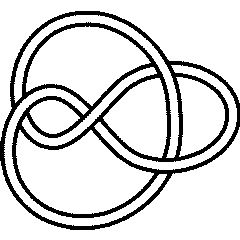The Coloured Jones Polynomials: Difference between revisions
No edit summary |
DrorsRobot (talk | contribs) No edit summary |
||
| Line 11: | Line 11: | ||
n1 = 2 | |
n1 = 2 | |
||
in = <nowiki>ColouredJones</nowiki> | |
in = <nowiki>ColouredJones</nowiki> | |
||
out= <nowiki>ColouredJones[ |
out= <nowiki>ColouredJones[K, n][q] returns the coloured Jones polynomial of a knot in colour n (i.e., in the (n+1)-dimensional representation) in the indeterminate q. Some of these polynomials have been precomputed in KnotTheory`. To force computation, use ColouredJones[K,n, Program -> "prog"][q], with "prog" replaced by one of the two available programs, "REngine" or "Braid" (including the quotes). "REngine" (default) computes the invariant for closed knots (as well as links where all components are coloured by the same integer) directly from the MorseLink presentation of the knot, while "Braid" computes the invariant via a presentation of the knot as a braid closure. "REngine" will usually be faster, but it might be better to use "Braid" when (roughly): 1) a "good" braid representative is available for the knot, and 2) the length of this braid is less than the maximum width of the MorseLink presentation of the knot.</nowiki> | |
||
about= <nowiki>The |
about= <nowiki>The "REngine" algorithm was written by Siddarth Sankaran in the summer of 2005, while the "Braid" algorithm was written jointly by Dror Bar-Natan and Stavros Garoufalidis. Both are based on formulas by Thang Le and Stavros Garoufalidis; see [Garoufalidis, S. and Le, T. "The coloured Jones function is q-holonomic." Geom. Top., v9, 2005 (1253-1293)].</nowiki>}} |
||
<!--END--> |
<!--END--> |
||
Revision as of 12:57, 14 September 2005
KnotTheory` can compute the coloured Jones polynomial of braid
closures, using the same formulas as in [Garoufalidis Le]:
(For In[1] see Setup)
|
| ||||||||
Thus, for example, here's the coloured Jones polynomial of the knot 4_1 in the 4-dimensional representation of :
In[3]:=
|
ColouredJones[Knot[4, 1], 3][q]
|
Out[3]=
|
-12 -11 -10 2 2 3 3 2 4 6
3 + q - q - q + -- - -- + -- - -- - 3 q + 3 q - 2 q +
8 6 4 2
q q q q
8 10 11 12
2 q - q - q + q
|
And here's the coloured Jones polynomial of the same knot in the two dimensional representation of ; this better be equal to the ordinary Jones polynomial of 4_1!
In[4]:=
|
ColouredJones[Knot[4, 1], 1][q]
|
Out[4]=
|
-2 1 2
1 + q - - - q + q
q
|
In[5]:=
|
Jones[Knot[4, 1]][q]
|
Out[5]=
|
-2 1 2
1 + q - - - q + q
q
|
 4_1 |
 3_1 |
| ||||
The coloured Jones polynomial of 3_1 is computed via a single summation. Indeed,
In[7]:=
|
s = CJ`Summand[Mirror[Knot[3, 1]], n]
|
Out[7]=
|
(3 n)/2 + n CJ`k[1] + (-n + 2 CJ`k[1])/2 1
{CJ`q qBinomial[0, 0, ----]
CJ`q
1 1
qBinomial[CJ`k[1], 0, ----] qBinomial[CJ`k[1], CJ`k[1], ----]
CJ`q CJ`q
n 1 n 1
qPochhammer[CJ`q , ----, 0] qPochhammer[CJ`q , ----, CJ`k[1]]
CJ`q CJ`q
n - CJ`k[1] 1
qPochhammer[CJ`q , ----, 0], {CJ`k[1]}}
CJ`q
|
The symbols in the above formula require a definition:
| ||||
| ||||
More precisely, qPochhammer[a, q, k] is
and qBinomial[n, k, q] is
The function qExpand replaces every occurence of a qPochhammer[a, q, k]
symbol or a qBinomial[n, k, q] symbol by its definition:
| ||||
Hence,
In[11]:=
|
qPochhammer[a, q, 6] // qExpand
|
Out[11]=
|
2 3 4 5
(-1 + a) (-1 + a q) (-1 + a q ) (-1 + a q ) (-1 + a q ) (-1 + a q )
|
In[12]:=
|
First[s] /. {n -> 3, CJ`k[1] -> 2} // qExpand
|
Out[12]=
|
11 2 3
CJ`q (-1 + CJ`q ) (-1 + CJ`q )
|
Finally,
| ||||
[Garoufalidis Le] ^ S. Garoufalidis and T. Q. T. Le, The Colored Jones Function is -Holonomic, Georgia Institute of Technology preprint, September 2003, arXiv:math.GT/0309214.



